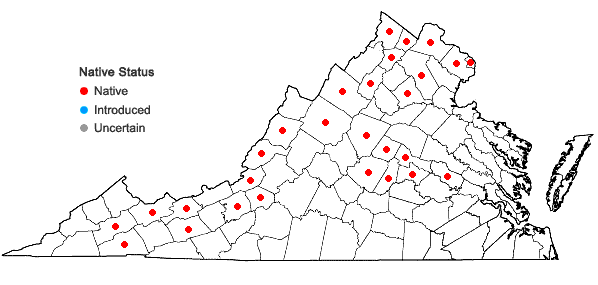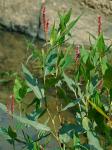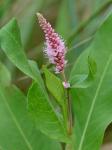Persicaria amphibia (L.) Gray

Detail
- Family
- Polygonaceae
- Botanical Name
- Persicaria amphibia (L.) Gray
- Common Name
- Water Smartweed
- Synonym(s)
- Persicaria amphibia ssp. laevimarginata (Hultén) Soják; Persicaria coccinea (Muhl.) Greene; Persicaria amphibia var. emersa (Michx.) J.C. Hickm.; Persicaria amphibia var. stipulacea (N. Colem.) H. Hara; Polygonum amphibium L.
- Flora of Virginia Name/Status
- Persicaria amphibia (L.) S.F. Gray
- Comments
- Two varieties, with a broad range of intermediates, have often been recognized. Experimental studies by R.S. Mitchell (former curator at VPI), show that no single character will identify varieties, hence, "a key is impractical." Nevertheless, they can be quite distinctive in the field. Var. emersa (Michx.) J.C. Hickman is typically strongly erect or emergent, without floating shoots and leaves; its inflorescences are 4-15 cm, its peduncles glandular pubescent, and its stipules not flanged with a collar. Var. stipulacea (N. Coleman) H. Hara often flowers in the water with inflorescences 4 cm or less; its aquatic forms glabrous, land forms sprawling and quite pubescent, stipules of all forms flanged. More recently, Flora of the Southeastern U.S. has followed Haines (2011, Flora Novae Angliae) in recognizing two species - P. coccinea and P. amphibia ssp. laevimarginata - that more or less correspond to the traditional varieties.
It is currently unclear how well any of these concepts apply to Virginia material since herbarium specimens have almost all been identified only as "Persicaria amphibia" or "Polygonum amphibium." But we do know that the characters that supposedly distinguish these two are quite variable and, perhaps more importantly, not always perfectly correlated; and some of the variability appears (subjectively) related to habitat factors such as length and depth of flooding. Consequently, the treatment here (and by Flora of Virginia) follows that in FNA5 of Freeman and Reveal (2005), who argue against the recognition of infraspecific taxa because of polymorphism and a nearly continuous cline of morphological variation in the North American populations. Overall, the taxonomy of this complex seems unsettled and in need of molecular study that includes both North American and Eurasian material. Until greater clarity is attained, we will opt to (and must for mapping purposes) continue with the current, lumped approach. - Habitat
- Calcareous marshes, wet meadows, depression ponds, floodplain pools and ponds; also on flood-scoured rocky, gravelly, and sandy bars and shores. Infrequent in the mountains and n. and c. Piedmont; rare in freshwater tidal marshes of the inner Coastal Plain.
- Native Status
- Native
To save this map, right-click (control-click for Mac users) on the map and choose "Save Image As...".





